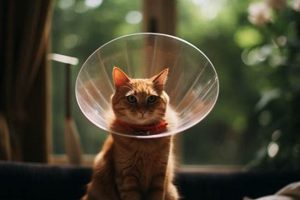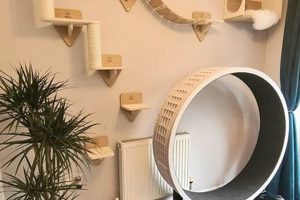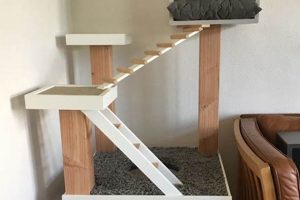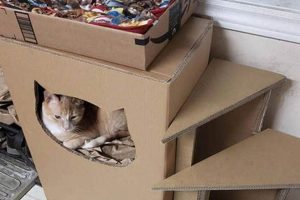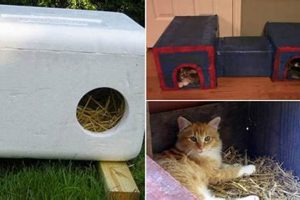Creating customized feline activity centers, or structures designed to meet a cats innate needs for climbing, scratching, and resting, is a prevalent trend among cat owners. These personalized pieces of pet furniture can range from simple constructions using repurposed materials to elaborate, multi-tiered designs resembling miniature trees.
The construction of these specialized cat structures offers several advantages. It allows for cost-effective pet care, enabling owners to avoid the expenses associated with commercially produced items. Furthermore, it facilitates the creation of pieces tailored to the specific size, age, and physical abilities of the cat, as well as the owners aesthetic preferences and available space. Historically, providing indoor cats with appropriate outlets for their natural behaviors has been recognized as crucial for their physical and mental well-being, preventing destructive behaviors stemming from boredom or lack of stimulation.
The subsequent sections will delve into specific design considerations, material selection, and step-by-step construction techniques applicable to building these feline enrichment structures. This will include examining the structural integrity required for safe usage, exploring suitable scratching post materials, and providing guidance on creating comfortable resting platforms.
Construction Guidance for Feline Activity Centers
The creation of robust and appealing feline activity centers requires careful consideration of several factors. The following guidelines aim to assist in the design and construction process, promoting both safety and feline enjoyment.
Tip 1: Prioritize Stability: The structural base must be sufficiently weighted and dimensioned to prevent tipping, especially during active use by the cat. Consider incorporating a wide footprint or a heavy base material like solid wood or concrete.
Tip 2: Select Appropriate Materials: Opt for non-toxic, durable materials suitable for scratching and climbing. Sisal rope, untreated wood, and sturdy carpeting are generally considered safe and effective choices.
Tip 3: Ensure Secure Fastening: All connections must be robustly secured to prevent separation or collapse. Screws, bolts, and construction adhesive should be used to create stable joints. Regularly inspect and tighten connections as needed.
Tip 4: Design for Cat Anatomy: Platform sizes should be adequate for a cat to comfortably sit, stand, and turn around. Heights between levels should accommodate jumping ability without posing a risk of injury.
Tip 5: Incorporate Variety: Integrate different textures, levels, and features to cater to a range of feline preferences. Include scratching surfaces, enclosed spaces, and elevated perches to provide stimulation and comfort.
Tip 6: Consider Placement: Position the finished structure in an area of the home that offers the cat a good vantage point and exposure to activity, encouraging its use.
Tip 7: Upholstery Matters: If using fabric, ensure it is securely attached and free from loose threads or staples that could be ingested by the cat. Avoid fabrics that fray easily.
Tip 8: Safety First: All edges should be smooth and free of sharp points. Regularly inspect the structure for signs of wear and tear, and promptly repair any damage that could pose a hazard.
Adhering to these guidelines will contribute to the creation of a safe and engaging feline activity center, promoting physical activity and enriching the cat’s environment.
The concluding section will summarize the key considerations and offer recommendations for long-term maintenance.
1. Stability
The stability of any self-constructed feline activity center is paramount. Insufficient stability represents a direct safety hazard to the animal, potentially resulting in injury from tipping or collapse during use. Stability is not merely a desirable characteristic, but a fundamental requirement for ethical and responsible design and construction. The absence of a robust and stable base negates any potential benefits derived from the structure, rendering it a hazardous element within the domestic environment.
Causes of instability in these structures typically stem from inadequate base dimensions, insufficient weight distribution, or compromised joinery. Real-world examples abound, ranging from hastily constructed trees with narrow bases that topple under a cat’s weight, to multi-tiered structures with poorly secured platforms that separate under stress. The practical significance of understanding this lies in the prevention of injuries, both minor and severe, to the animal. A stable structure allows the cat to engage in natural behaviors such as climbing, scratching, and jumping without the risk of unintended falls or structural failure.
In conclusion, structural stability is not merely a design consideration, but an ethical imperative in the context of self-constructed feline activity centers. A secure and stable foundation safeguards the animal’s well-being, enabling the intended benefits of environmental enrichment and behavioral stimulation without the inherent risk of injury. The initial investment in proper design and construction techniques relating to stability mitigates the potential for future harm and ensures the long-term viability of the structure as a safe and enriching component of the cat’s environment.
2. Materials
The selection of appropriate materials is a critical determinant in the success and longevity of any handcrafted feline climbing structure. Material properties directly impact the safety, durability, and overall appeal of the finished product, influencing feline interaction and the integration of the structure within the domestic environment.
- Structural Support Materials
The framework of a feline activity center often relies on wood, PVC pipe, or metal. Wood, particularly untreated varieties, provides a stable and readily customizable option. PVC offers a lightweight and weather-resistant alternative, though its structural integrity may be lower than wood. Metal provides superior strength but requires specialized tools for cutting and joining. Material selection should be based on desired size, weight limitations, and structural complexity of the final project.
- Scratching Surfaces
Providing appropriate scratching surfaces is essential for feline well-being and damage prevention within the home. Sisal rope is widely regarded as the ideal material due to its durability and natural texture. Carpet remnants, while cost-effective, may not withstand prolonged scratching and can shed fibers. Corrugated cardboard offers a disposable option but requires frequent replacement. The choice of scratching material directly influences the cat’s engagement with the structure and its protective function for household furnishings.
- Covering and Padding Materials
The comfort and aesthetic appeal of platforms and resting areas are enhanced through the use of covering materials. Fleece, faux fur, and durable fabrics are common choices. These materials should be non-toxic, resistant to tearing, and easily cleaned. The texture and color of the covering material can influence a cat’s preference for specific areas of the structure, thereby impacting its overall usability.
- Fastening and Securing Elements
The strength and stability of a completed feline activity center are contingent upon the selection and application of appropriate fastening methods. Screws, bolts, and construction adhesives are essential for creating secure joints. Staples, while useful for attaching fabric coverings, should be used sparingly and with caution to prevent potential injury to the animal. The integrity of these connections directly correlates with the safety and longevity of the structure.
The interplay between these material categories highlights the multifaceted considerations necessary when embarking on a “diy cat tree ideas” project. The structural materials dictate the framework’s stability, the scratching surfaces cater to the cat’s instinctive behaviors, the covering materials ensure comfort and aesthetic integration, and the fastening elements guarantee overall structural integrity. A well-informed approach to material selection is thus fundamental to creating a safe, functional, and aesthetically pleasing feline enrichment structure.
3. Construction
The act of construction represents the pivotal stage in realizing any “diy cat tree ideas,” transforming conceptual designs and selected materials into a tangible, functional structure. Construction is not merely the assembly of components but a process demanding adherence to sound engineering principles, attention to detail, and a thorough understanding of feline behavior to ensure the final product is both safe and appealing.
The quality of construction directly impacts the stability, durability, and overall usability of the feline activity center. Faulty construction, such as improperly secured joints or inadequately supported platforms, can lead to structural failure, posing a significant safety risk to the cat. Real-world examples include leaning or collapsing structures due to insufficient support beams, sharp edges or exposed fasteners causing injuries, and poorly attached scratching surfaces detaching during use. These examples underscore the practical significance of employing robust construction techniques and meticulous execution. Techniques such as pre-drilling pilot holes before driving screws, applying construction adhesive in conjunction with mechanical fasteners, and using appropriate clamping mechanisms during assembly are essential. Furthermore, understanding feline anatomy and behavior informs the design of climbing heights, platform sizes, and the placement of scratching surfaces, contributing to the structure’s functionality and appeal. Construction, therefore, acts as the crucial link between design and realization, determining the long-term viability and safety of the feline activity center.
In summary, construction stands as the defining element in bringing “diy cat tree ideas” to fruition. The challenges inherent in the construction phase necessitate a blend of technical skill, meticulous attention to detail, and an understanding of feline needs. Successful construction translates into a stable, durable, and engaging structure that enriches the cat’s environment while minimizing safety risks. The principles of sound construction are not simply guidelines but fundamental requirements for responsible creation.
4. Placement
The strategic positioning of a self-constructed feline activity center is integral to its effective utilization and the enrichment of the cat’s environment. Placement, beyond simple spatial allocation, directly influences the cat’s inclination to interact with the structure and its overall contribution to their well-being. Improper placement negates the potential benefits of an otherwise well-designed and constructed “diy cat tree ideas” project, rendering it functionally useless or even a source of anxiety for the animal.
The factors governing optimal placement are multifaceted, encompassing feline behavioral patterns, environmental dynamics, and the cat’s individual preferences. Cats exhibit an innate predilection for elevated vantage points, allowing them to survey their surroundings and establish a sense of security. Placing the structure near windows provides access to natural light and external stimuli, fostering environmental enrichment. Conversely, positioning the structure in high-traffic areas or near sources of excessive noise may deter usage, inducing stress and undermining the intended purpose. The practical significance of understanding these dynamics lies in the maximization of feline engagement and the integration of the structure into the cat’s established territory. For instance, a tree placed near a favorite sleeping spot is more likely to be adopted than one relegated to a seldom-used corner. Similarly, a structure located within the cat’s line of sight to a window overlooking a bird feeder offers an engaging source of visual stimulation, promoting both physical activity and mental enrichment.
In conclusion, placement transcends mere physical positioning, representing a critical design consideration that directly impacts the efficacy of “diy cat tree ideas”. The successful integration of a feline activity center into the cat’s environment hinges on a thorough understanding of feline behavior and the strategic consideration of environmental factors. Thoughtful placement transforms a static structure into a dynamic element of feline enrichment, fostering physical activity, mental stimulation, and a heightened sense of security, thereby maximizing its contribution to the animal’s overall well-being.
5. Functionality
Functionality constitutes a core determinant in the success of any “diy cat tree ideas” endeavor. Structures lacking in functionality, regardless of aesthetic appeal, are unlikely to provide meaningful enrichment for feline inhabitants. The absence of functional design can result in underutilization, rendering the construction effort unproductive and failing to address the innate behavioral needs of the animal. Cause and effect are directly linked: inadequate functionality causes disinterest or avoidance, while well-considered functionality promotes interaction and utilization.
The importance of functionality manifests in several key areas. Scratching surfaces must be suitably textured and appropriately positioned to encourage use, protecting furniture and promoting nail health. Platforms should be sized and spaced to accommodate comfortable resting and safe climbing. Enclosed spaces provide security and privacy, catering to the cat’s natural inclination for seclusion. Real-life examples illustrate this point: A cat tree with tightly spaced platforms may be unsuitable for larger breeds, while a tree lacking scratching surfaces will likely result in displaced scratching behavior directed towards household items. The practical significance of understanding these functional requirements lies in the creation of structures that cater directly to the cat’s physical and behavioral needs, fostering a positive interaction with the environment and minimizing undesirable behaviors.
In summary, functionality is paramount within the realm of “diy cat tree ideas.” Overlooking functional design compromises the core purpose of the project, leading to underutilization and a failure to enrich the cat’s environment. A functional design, conversely, directly addresses the cat’s behavioral needs, promoting interaction, providing enrichment, and minimizing destructive tendencies. The incorporation of functional considerations into the design and construction process is thus not merely a suggestion, but a fundamental requirement for a successful and beneficial outcome.
6. Aesthetics
The aesthetic integration of a feline activity center within a domestic environment represents a nuanced aspect of “diy cat tree ideas”. While functionality and structural integrity remain paramount, the visual harmony between the structure and its surroundings contributes significantly to owner satisfaction and the overall cohesiveness of the living space. Aesthetic considerations, therefore, are not merely superficial but represent a thoughtful approach to integrating pet enrichment into the human-occupied environment.
- Color Palette Coordination
The selection of colors for covering materials, structural components, and decorative elements can significantly influence the perceived compatibility of the cat tree with existing dcor. Neutral tones, such as grays, beiges, and creams, tend to blend seamlessly into a variety of interior styles. Conversely, bold or contrasting colors can create a focal point or complement existing accent hues. Real-world examples include matching the fabric of the cat tree’s platforms to the upholstery of nearby furniture or incorporating wood finishes that echo the tones of existing cabinetry. The implication of color palette coordination lies in achieving visual harmony rather than creating a distracting or clashing element within the room.
- Material Texture and Surface Finishes
The texture and finish of materials contribute to the overall tactile and visual appeal of the cat tree. Smooth, polished wood surfaces offer a contemporary aesthetic, while textured fabrics and natural sisal rope provide a more rustic or organic feel. Examples include using reclaimed wood with a distressed finish to create a vintage-inspired look or incorporating plush, high-pile carpeting for a luxurious and inviting feel. The careful selection of textures and finishes can enhance the aesthetic integration of the cat tree and cater to the owner’s personal style preferences.
- Form and Silhouette Design
The overall form and silhouette of the cat tree can impact its visual presence within the room. Simple, geometric shapes tend to integrate well into modern interiors, while more elaborate or organic designs can serve as decorative focal points. Examples include minimalist, tower-like structures that maximize vertical space or sprawling, multi-tiered designs that mimic the form of a natural tree. The shape of the cat tree should complement the existing architectural lines and spatial arrangement of the room, avoiding visual clutter or obstruction.
- Decorative Accents and Personalization
The incorporation of decorative accents and personalized elements allows for the further customization of the cat tree’s aesthetic. Examples include adding decorative trim, incorporating small shelves for displaying pet toys, or attaching personalized nameplates. These details contribute to the unique character of the structure and demonstrate a thoughtful integration of pet enrichment into the home environment. Personalization should be balanced with functionality, avoiding excessive ornamentation that could pose a hazard to the cat.
The confluence of these aesthetic considerations transforms a functional feline structure into an integrated design element within the home. The synthesis of color palette coordination, material texture, form, and personalization contributes to a cohesive and visually appealing outcome. Successful integration of aesthetics allows the “diy cat tree ideas” to coexist harmoniously within the human living space, enhancing both the cat’s well-being and the owner’s aesthetic satisfaction.
Frequently Asked Questions
This section addresses common inquiries regarding the planning, construction, and maintenance of self-made feline activity centers. The information provided aims to clarify misconceptions and offer practical guidance.
Question 1: Is specialized expertise required for crafting a feline activity center?
While advanced carpentry skills are not mandatory, a foundational understanding of structural mechanics and material properties is beneficial. Simple designs can be executed with basic tools and readily available materials. However, complex designs necessitate a greater degree of technical proficiency.
Question 2: What measures mitigate the risk of structural instability?
Structural stability is paramount. The incorporation of a wide, weighted base, the utilization of robust fastening methods, and the selection of durable materials are crucial. Rigorous testing of the structure prior to feline inhabitation is highly recommended.
Question 3: How does one ensure the materials utilized are non-toxic and safe for feline interaction?
Select materials explicitly labeled as non-toxic and pet-safe. Untreated wood, natural fiber ropes (e.g., sisal), and fabrics free from chemical treatments are generally considered appropriate. Thorough research into the composition of all materials is essential.
Question 4: What is the recommended frequency for inspecting and maintaining a feline activity center?
Regular inspection, ideally on a monthly basis, is advisable. Examine all connections for looseness, assess the condition of scratching surfaces, and promptly repair any damage. Proactive maintenance extends the lifespan of the structure and ensures feline safety.
Question 5: Can pre-existing furniture be repurposed into feline activity centers?
Repurposing is feasible, provided the furniture is structurally sound and free from hazardous materials. Remove or cover any sharp edges or protruding hardware. Thoroughly clean and disinfect the furniture prior to modification.
Question 6: How does one acclimate a feline to a newly constructed activity center?
Gradual introduction is key. Place the structure in an area frequented by the cat. Utilize feline attractants, such as catnip, to encourage exploration. Positive reinforcement, such as treats or praise, can further incentivize interaction.
Adherence to these principles enhances the likelihood of creating a safe, functional, and aesthetically pleasing feline activity center.
The subsequent section will provide guidance on troubleshooting common construction challenges.
Conclusion
The preceding exposition has illuminated the multifaceted aspects inherent in the creation of custom feline activity centers. Considerations ranging from structural integrity and material selection to placement and aesthetic integration constitute essential elements for project success. Effective implementation of “diy cat tree ideas” demands a commitment to safety, functionality, and a comprehensive understanding of feline behavioral needs.
The construction of these structures represents a tangible investment in the well-being of domestic felines, fostering physical activity, mental stimulation, and a sense of environmental security. The long-term benefits derived from a thoughtfully designed and meticulously constructed activity center extend beyond mere amusement, contributing to the overall health and happiness of the animal, and mitigating destructive tendencies within the household.


